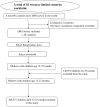Incomplete basic vaccination and associated factors among children aged 12-23 months in resource-limited countries: a spatial and multilevel regression analysis of recent DHS data from 48 countries
- PMID: 40297029
- PMCID: PMC12036240
- DOI: 10.3389/fpubh.2025.1463303
Incomplete basic vaccination and associated factors among children aged 12-23 months in resource-limited countries: a spatial and multilevel regression analysis of recent DHS data from 48 countries
Abstract
Background: Childhood basic vaccinations are a cost-effective and essential preventive health strategy globally in resource-limited nations. The United Nations Sustainable Development Goals aim to reach these ambitious targets, making it crucial to identify underserved populations and address the barriers they face in accessing life-saving immunizations. To date, no spatial analyses have been performed to identify areas of hotspots of incomplete basic vaccination among children in resource-limited countries globally. Therefore, determining the geographic distribution of incomplete basic vaccinations and associated factors is important for prioritizing intervention programs in resource-limited countries.
Objective: This study aims to assess incomplete basic vaccinations and associated factors among children aged 12-23 months in resource-limited countries based on the recent Demographic and Health Survey (DHS) data of 48 countries.
Methods: Data for the study were drawn from the DHS, a nationally representative cross-sectional survey conducted by considering the era of Millennium Development Goals and Sustainable Development Goals. A total of 48 resource-limited countries and a total weighted sample of 202,029 children (12-23 months) were included in our study. The data extraction, recoding, and analysis were conducted using STATA V.17. For the spatial analysis (spatial distribution, autocorrelation, and hotspot), ArcGIS version 10.7 software was used, and for the SaTScan analysis, SaTScan version 10.1 software was used. Descriptive statistics were presented using frequency tables and percentages. We employed multilevel logistic regression to investigate the associated factors of incomplete basic vaccination. In the multivariable analysis, variables with a p-value of ≤0.05 are considered significant factors associated with incomplete basic vaccination among children aged 12-23 months.
Results: The overall incompleteness of basic vaccination among children in resource-limited countries was 51% (95%CI: 50-51%). The spatial analysis revealed that the incomplete basic vaccination among children significantly varied across resource-limited countries (Global Moran's I = 0.208468, p < 0.001). The most likely clusters were located in Nigeria, Chad, Cameroon, and Niger, which were centered at (2.028929N, 15.135990 E)/1425.16 km radius, with a Log-Likelihood Ratio (LLR) of 3519.48 and a Relative Risk (RR) of 1.38 at p-value <0.001. Based on the final model of multilevel analysis, the following variables were statistically significant in relation to incomplete basic vaccination: age, marital status, maternal education, husband's education, maternal occupation, media exposure, wealth index, antenatal care (ANC) visits, birth order, place of delivery, mode of delivery, health insurance coverage, perception of distance from a health facility, place of residence, community media exposure, community education, and country-level income status.
Conclusion and recommendations: The spatial distribution of incomplete basic vaccination was significantly varied across the resource-limited countries. Both individual- and community-level factors were significantly associated with incomplete basic vaccination. Therefore, the World Health Organization and other stakeholders involved in child healthcare should work together to expand childhood vaccination and prioritize the hotspot areas of developing countries.
Keywords: children; countries; incomplete; resource limited; vaccination.
Copyright © 2025 Getnet, Jejaw, Belachew, Addis, Dellie, Tafere, Worku, Geberu, Yazachew, Teshale, Tiruneh and Demissie.
Conflict of interest statement
The authors declare that the research was conducted in the absence of any commercial or financial relationships that could be construed as a potential conflict of interest.
Figures






Similar articles
-
Spatial distribution and associated factors of co-occurrence of overweight/obesity and Anemia among women in the reproductive age in sub-Saharan Africa: A multilevel analysis, DHS 2016-2021.PLoS One. 2024 Apr 18;19(4):e0299519. doi: 10.1371/journal.pone.0299519. eCollection 2024. PLoS One. 2024. PMID: 38635643 Free PMC article.
-
Complete basic childhood vaccination and associated factors among children aged 12-23 months in East Africa: a multilevel analysis of recent demographic and health surveys.BMC Public Health. 2020 Dec 1;20(1):1837. doi: 10.1186/s12889-020-09965-y. BMC Public Health. 2020. PMID: 33256701 Free PMC article.
-
Spatial variation and predictors of incomplete pneumococcal conjugate vaccine (PCV) uptake among children aged 12-35 months in Ethiopia: spatial and multilevel analyses.Front Public Health. 2024 May 28;12:1344089. doi: 10.3389/fpubh.2024.1344089. eCollection 2024. Front Public Health. 2024. PMID: 38864011 Free PMC article.
-
Systematic review of social determinants of childhood immunisation in low- and middle-income countries and equity impact analysis of childhood vaccination coverage in Nigeria.PLoS One. 2024 Mar 6;19(3):e0297326. doi: 10.1371/journal.pone.0297326. eCollection 2024. PLoS One. 2024. PMID: 38446836 Free PMC article.
-
Number of tetanus toxoid injections before birth and associated factors among pregnant women in low and middle income countries: Negative binomial poisson regression.Hum Vaccin Immunother. 2024 Dec 31;20(1):2352905. doi: 10.1080/21645515.2024.2352905. Epub 2024 May 21. Hum Vaccin Immunother. 2024. PMID: 38772729 Free PMC article. Review.
References
-
- Vakili R, Ghazizadeh Hashemi A, Khademi G, Ajilian Abbasi M, Saeidi M. Immunization coverage in WHO regions: a review article. Int J Pediatr. (2015) 3:111–8.
MeSH terms
LinkOut - more resources
Full Text Sources
Medical

